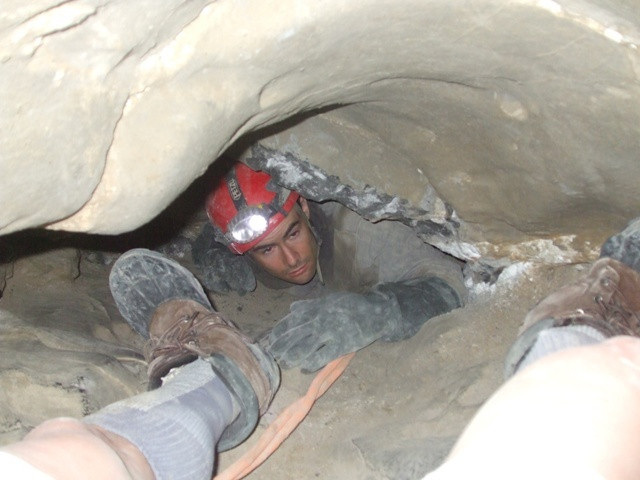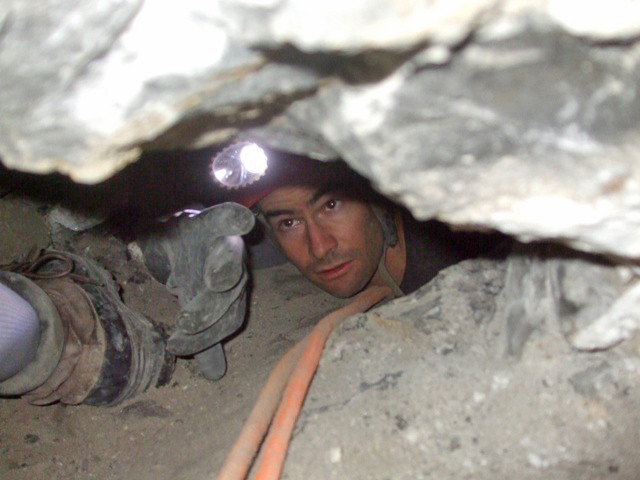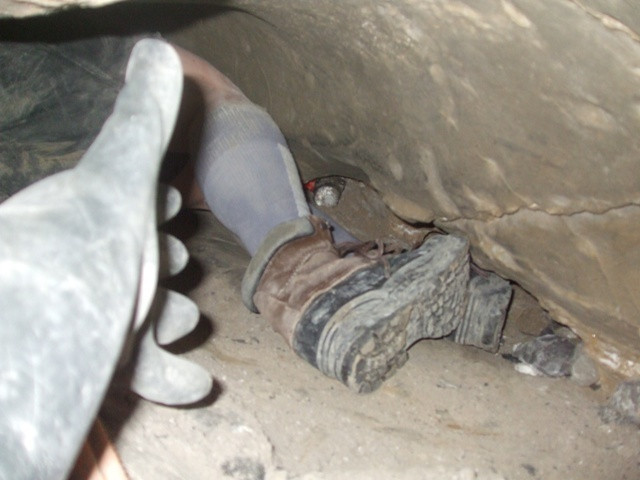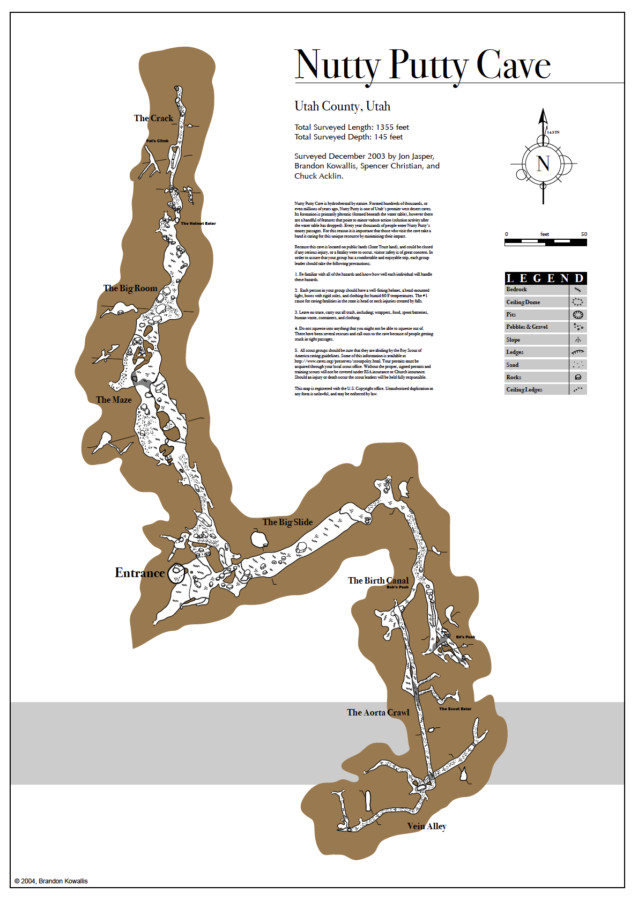The Nutty Putty Cave, a popular destination for cavers in Utah, became the site of a tragic incident on the day before Thanksgiving in 2009. John Edward Jones, while exploring the cave, became trapped in a narrow, uncharted passage. I, as a member of the caving community, was called in to assist with the rescue efforts. This is my account of that harrowing experience, offering a personal perspective on the events surrounding the John Jones Cave rescue at Nutty Putty. While viral videos and renewed interest have recently brought this event back into the spotlight, I aim to provide a detailed and informative account to answer the many questions that have arisen, based on my direct involvement in the latter stages of the operation.
This report is based on detailed notes I wrote immediately following the unsuccessful rescue attempt. It represents my perspective as someone who arrived on the scene as the initial efforts were waning. For a more comprehensive understanding, I recommend reading Lindsay Whitehurst’s two-part article in the Salt Lake Tribune, which offers a broader view of the Nutty Putty cave incident.
WARNING: The following account contains descriptions of John Jones’s condition, his passing, and circumstances after his death. These details may be disturbing to some readers. Out of respect for John and his family, I have aimed to be as general as possible in my descriptions while still accurately portraying the immense challenges we faced during the Nutty Putty cave rescue.
Nutty Putty Rescue Report
Written for SAR on November 25, 2009
My involvement in the Nutty Putty cave rescue began with a phone call around 9:00 or 10:00 AM on that fateful day. Spencer Christian and Rodney Mulder contacted me, informing me of an ongoing rescue operation at Nutty Putty Cave. They initially inquired about my availability to assist, but after discussing the situation and the number of personnel already present, it seemed that sufficient resources were in place. I offered to be on standby, telling Spencer and Rodney that if the rescue became prolonged and exhaustion set in, and if my assistance became absolutely necessary, I would come.
Approximately five hours later, around 4:00 PM, Spencer called again, this time urgently requesting my presence. He explained that the rescue was indeed dragging on, rescuers were tiring, and they were in dire need of cavers with smaller physiques who could navigate the tight passages. I immediately left work, rushed home to gather my caving equipment, and drove to Nutty Putty Cave. I arrived at the site around 6:00 PM and was assigned to the next team to enter the cave at approximately 6:30 PM.
Upon reaching the main passage at the entrance of the Birth Canal, I observed rescuers working on a 4-to-1 haul system that had been established. I assisted with this system for about five minutes. However, it became apparent that the system was not effectively moving John Jones (1), and the team working directly with him needed relief. The cavers who had been attending to John then began to exit the passage.
As they emerged, I spoke with Andy Armstrong. I inquired about John’s condition, and Andy’s report was grim. He indicated that John was rapidly deteriorating, drifting in and out of consciousness, and had begun experiencing hallucinations, speaking of seeing angels and demons.
Following this sobering update, it was decided that I would proceed into the passage first to assess the situation firsthand and explore any potential strategies for extracting John. Debbie, who had already spent time with John and felt she had established a rapport with him, would follow to provide comfort and support.
I entered the passage, moving towards the area where John was trapped. Just before reaching his location, there is an incredibly constricted crawl – perhaps only 18 inches wide and 8 to 10 inches high – requiring a sharp 90 to 120-degree turn. This section must be navigated feet first. The tight dimensions and sharp turn make it impossible to see where your feet are placed until you are almost completely through the restriction. As I carefully wormed my way through this narrow passage, my feet encountered something soft. It was John’s feet. I felt a slight movement, immediately lifted my feet, and shifted horizontally into the fissure.
John’s feet were positioned approximately 6 feet beyond the constriction. I was able to maneuver myself to his side and descend slightly into the 4-foot-wide fissure where he was trapped. After wedging myself securely into a narrower section of the crack to gain stability, I began speaking to John, introducing myself and asking about his condition. There was no response. I shifted my position slightly and tapped his leg. I heard a deep, gurgling breath, sounding as if his lungs were filling with fluid. Then, his feet began to kick frantically, as if he were desperately trying to dislodge his legs from the crack. This frantic movement lasted only a moment before he ceased moving, appearing to slip into unconsciousness (2). I continued tapping his legs and hip, attempting to elicit a response, but there was none.
From this vantage point, I spent several minutes carefully examining the passage, John’s positioning within it, and the existing rigging system, trying to discern a viable method for his extraction. The situation appeared dire. I questioned whether it was even physically possible to move him further. We could continue to attempt the haul system, but it seemed he could only be lifted another foot or two in his current position due to the anchor point of the webbing around his knees. After that minimal lift, his feet would hit the ceiling of the passage. Once his feet reached the ceiling, there was no way to rotate him into a horizontal position. He would have to accomplish that himself, but he was now unresponsive. Even if we could somehow manage to get him horizontal, he would then face the most severely constricted sections of the passage that had trapped him initially. If John were conscious and at full strength, there might have been a slim chance of him maneuvering through. But even under those ideal circumstances, the outlook was bleak. It was exceedingly difficult even for me, weighing only 125 pounds, to extricate myself from the passage. At the sharp bend within the restriction, I had to contort my body in unconventional ways just to slip through. The prospect of extracting a 210-pound, unconscious man seemed virtually impossible.
The only other option I could envision was to use a jackhammer to widen the crack around him. This would involve removing several rock protrusions and widening the tightest point to allow for a straight pull. Such a method would undoubtedly cause significant physical trauma to John, likely resulting in severe lacerations and multiple broken bones. However, if all other methods failed, this drastic approach seemed like the only remaining possibility.
Between my exit from the passage and Debbie taking my place to assess the situation, a request came to bring a radio to John so his family could speak with him. I believe it was his father, mother, and wife who spoke to him, expressing their love, prayers, and his father giving him a priesthood blessing. His wife conveyed a sense of peace, expressing her belief that everything would be alright. She spoke to him for approximately 5 to 10 minutes before I interjected, explaining the urgent need to resume efforts to free him.
At that point, I crawled back out to allow Debbie to squeeze past me and assess the situation. However, as she reached the tight restriction, both of her legs cramped severely, preventing her from progressing further into the passage. It was then that I decided to attempt using the jackhammer. We waited for it to be brought to our location, and I then carried it down to where John was positioned. The tool was considerably heavier than I had anticipated, and supporting its weight while wedging myself into the narrow crack proved to be incredibly taxing. Even then, I struggled to achieve a good angle against the rock face due to the confined space and my limited mobility. I managed only three attempts at a small lip of rock just below John’s foot, but due to the awkward angle, the hammer bit kept slipping into the sand at the side of the rock lip. I tried adjusting my position, but in every other position, I found it impossible to effectively handle the jackhammer because of its length. I only had about 2.5 feet of clearance between me and the rock that needed to be drilled, while the jackhammer was probably 3 to 4 feet long. The awkward posture and exertion quickly exhausted me.
I then requested a smaller drilling tool, but it seemed none were available. Even if a smaller hammer drill had been accessible, I doubted whether it would have been effective against the solid limestone walls. We then returned to the Birth Canal area to convene a quick meeting and decide on the next course of action.
By this time, we learned that the drills were encountering problems, or something similar. The only remaining drilling option was to use a compressed air hammer. It took approximately an hour or so to get the air hose routed down into the cave so we could operate it. While we waited, we decided that perhaps the most effective approach would be to attempt widening the passage from the top down, working towards John’s location rather than away from it. Once the compressed air drill arrived, Debbie, Max, and I spent about an hour and a half chipping away at the passage ceiling a couple of feet above the tightest restriction – approximately 7 to 9 feet away from John. Areas where the rock was softer yielded relatively easily, but the harder formations required an immense amount of effort. The primary challenge was the extremely limited space, which made it difficult to strike the rock at an effective angle. Instead of chipping off the desired rock protrusion, we often ended up cutting straight into the cave floor.
After an hour and a half of strenuous work, we had only managed to remove a section of rock roughly 18 inches by 4 inches from both the ceiling and the ground. And this meager progress was made in a slightly wider section of the passage. From that point onward, the cave passage became even tighter. If you were lying in the passage, weighing 125 pounds, you would only have about 3 to 6 inches of clearance above you. This was hardly conducive to wielding a jackhammer or even finding a position that allowed for effective drilling angles. To continue this process, or even if we were to switch to micro-blasters, my estimated timeframe to reach John’s location was anywhere from 3 to 7 days. So, we regrouped once again to determine the next plan of action.
By now, it was nearing midnight, and we were asked to check John’s vital signs. A smaller paramedic was sent in to see if he could reach John. In case the paramedic couldn’t fit, he instructed me on how to use the stethoscope and thermometer and where to check for a pulse. It was 11:30 PM when we left the group at the Birth Canal and ventured back down the passage. It took about 15 minutes to reach John’s position. I went first to check, just in case the paramedic was unable to pass the tight restriction. I first attempted to use the stethoscope, but I could only insert it about 3 inches up and to the right of his navel. I did not hear a distinct heartbeat, only some rustling, fluttering sounds that were likely caused by my own shaking as I tried to steady myself in the awkward position. I then wedged my hand between the rock and pressed as far up his torso as I could reach to feel for breathing. I didn’t believe I felt anything, but again, it was difficult to be certain as I was shaking from the effort of maintaining my position. His chest, where it was pressed against the rock, felt warmer than the rest of his body and was damp with sweat, but everywhere else, his body temperature was close to the cold temperature of the cave walls. From there, I removed his shoe and attempted to take his temperature. The thermometer displayed no reading, which the paramedic later explained was because the temperature was below the device’s measurement range. As I removed his shoes and moved his feet, I noticed that his feet and legs were significantly stiffer than they had been earlier. It was difficult to move his leg more than a few inches.
I reported my findings to the paramedic waiting above and then crawled out so that he could try to squeeze in. He was able to reach down to the point where he could touch John’s feet and confirm that he had passed away. John Edward Jones was pronounced dead at 11:52 PM, I believe.
At that point, we decided to return to the surface for a debriefing to discuss our next course of action. As everyone began to exit the cave, the paramedic and I went back in one last time to take photographs of the passage and John’s position.
With John now deceased, the effort required to recover his body would be exponentially more challenging. His body, now undergoing rigor mortis, would be unable to bend through the tight restriction above his feet without significant alterations to the passage, which could take days or even weeks using a hammer drill, and possibly slightly faster with micro-blasters. Any swelling of the body would make it virtually impossible to remove him from the crack he was wedged in until the swelling subsided. There was no way to safely attach him to a rope except by his feet. After a few days, we would need hazmat suits and respirators to work with the body, which would severely overheat any rescuers attempting the recovery. Even in just pants and a short-sleeved shirt, rescuers typically become drenched in sweat within 10 to 15 minutes of exertion in the cave and can only work for about 30 minutes to an hour before needing a break. In a hazmat suit and respirator, work periods would likely be limited to 5-10 minutes before requiring rest, not to mention the significant restriction to mobility imposed by the suit. The prospect of body recovery looked extremely grim (3).
Commentary
- The 4-to-1 haul system proved ineffective due to the numerous twists and turns in the cave passage between the spacious area where the hauling team was positioned and John’s location. The cumulative friction, even with pulleys in place, was enough to render the system useless.
- This moment, when his frantic kicking ceased and he appeared to lose consciousness, was, in my estimation, the time of his passing.
- Ultimately, after considering the immense risks to rescuers and the near impossibility of a safe recovery, the agonizing decision was made that attempting to remove the body was too dangerous. To this day, Nutty Putty Cave remains John Jones’s final resting place.
Below is a rescue map I created after the Nutty Putty cave rescue operation. Jon Jasper, Spencer Christian, Chuck Acklin, and I had previously mapped Nutty Putty Cave in 2003, and we had surveyed the very passage where John Jones became trapped. I utilized this survey data to generate two profile views illustrating John’s trapped position and the passage dimensions. I have also included photographs taken during the rescue to provide a visual sense of the challenging environment.
 Nutty Putty Rescue Map
Nutty Putty Rescue Map
Photos from the Rescue
 Rescuers at the staging area outside the entrance of Nutty Putty Cave.
Rescuers at the staging area outside the entrance of Nutty Putty Cave.
 Brandon Kowallis and a paramedic navigating the tight passage in Nutty Putty Cave.
Brandon Kowallis and a paramedic navigating the tight passage in Nutty Putty Cave.
 Brandon Kowallis demonstrating the narrow passage dimensions above John Jones in Nutty Putty Cave.
Brandon Kowallis demonstrating the narrow passage dimensions above John Jones in Nutty Putty Cave.
 View of a paramedic's feet in the constricted passage above John Jones in Nutty Putty Cave.
View of a paramedic's feet in the constricted passage above John Jones in Nutty Putty Cave.
Map
Here is the complete map of Nutty Putty Cave that I drafted in 2003. It’s important to note that John Jones was not trapped in the Birth Canal itself, but rather in the Ed’s Push area, which is accessed by traversing the Birth Canal. For those interested in a more detailed view, a high-resolution PDF version of this map is available for personal use through Cave Maps.
 Nutty Putty Cave Map
Nutty Putty Cave Map
Animation of the Area Where John is Stuck
This animation, created in collaboration with an animator, provides a to-scale model of the specific section of Nutty Putty Cave where John Jones was trapped. While it is not as precise as a lidar scan would be, and some areas appear slightly wider than reality, it is the most accurate visual representation available, particularly because the animator used our survey data to generate it.
[Animation of Nutty Putty Cave Area](URL to Animation if available, otherwise remove this section if no URL provided in original)
The Nutty Putty Entrance Today
This short video, recorded on my phone, shows the entrance to Nutty Putty Cave as it appears today:
[Video of Nutty Putty Entrance](URL to Video if available, otherwise remove this section if no URL provided in original)
Recent Salt Lake Tribune Short
The Salt Lake Tribune recently conducted an interview with me regarding the Nutty Putty Cave incident. The accompanying article, providing a retrospective 15 years after the tragedy, can be found here: 15 years after a man died in the Nutty Putty Cave, his family and rescuers still struggle to escape the darkness.
Tight Squeezes
To illustrate the nature of navigating extremely tight passages in caves like Nutty Putty, I have included two videos filmed during the survey of a desert cave in Utah. The first video shows Mitch attempting a challenging downward squeeze, while the second captures my exit from a narrow passage I explored that ultimately dead-ended about 12 feet below. For many, passages like these represent a terrifying prospect, but for experienced cavers, they are simply part of the exploration and can even be considered enjoyable.
[Video of Mitch in Tight Squeeze](URL to Video if available, otherwise remove this section if no URL provided in original)
[Video of Brandon Kowallis exiting Tight Passage](URL to Video if available, otherwise remove this section if no URL provided in original)
Comment about Comments Below
I deeply appreciate the kind and encouraging words expressed in the comments section, as well as the thoughtful questions. However, due to family commitments, a full-time job, and a desire to continue pursuing caving, climbing, and other activities, my time for responding to lengthy series of questions is limited as of 9/27/24. If you have questions, please review the existing comments to avoid repetition and focus on inquiries that are not speculative or related to events before my arrival at the Nutty Putty cave rescue site. I will approve all family-friendly comments, but please allow up to a week for approval.
If I release any further information, such as a video update, I will notify my email list subscribers. You can subscribe to my mailing list on this page. You can also follow me on YouTube for notifications of new content.
Thank you again for your understanding and kind words.

